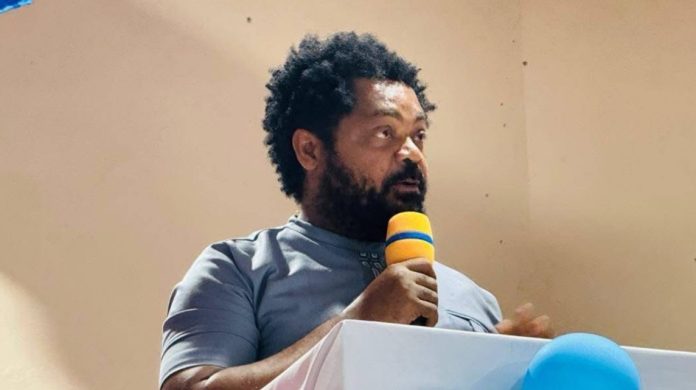AYV News, February 24, 2025
These were the words of the Chief Journalist of the Sierra Leone Association of Journalists, Ahmed Sahid Nasralla, while speaking at the Women in the Media Sierra Leone (WIMSAL) Annual General Meeting in Makeni.
He said gender disparities in leadership, discrimination, harassment in newsrooms, unequal pay, and ingrained biases have hindered the professional growth of female journalists.
Chief Nasralla said: “Today’s theme, ‘The Role of Women in Media and Gender Equality: The Future of Women in Media Sierra Leone,” is not just timely—it is essential. It compels us to reflect on our progress, confront persistent challenges, and chart a bold path forward for gender equality in the media.”
He assured that SLAJ has always been, and will continue to be, a strong supporter of WIMSAL as a very important affiliate body.
“Beyond words, our collaboration is built on action—we will continue to work together to create safer workspaces, eliminate harassment, and ensure equal opportunities for women in the profession.” Chief Nasralla stated.
Statement by SLAJ President, Ahmed Sahid Nasralla, at the WIMSAL Annual General Meeting at UNIMAK Auditorium in Makeni, with the theme: ‘The Role of Women in Media and Gender Equality: The Future of Women in Media Sierra Leone’.
Opening courtesies…
Good morning, distinguished guests, colleagues, and trailblazing women in the media.
It is both an honor and a privilege to stand before you today in a room filled with remarkable women—women who continue to break barriers, challenge stereotypes, and redefine the landscape of journalism in Sierra Leone.
Today’s theme, “The Role of Women in Media and Gender Equality: The Future of Women in Media Sierra Leone,” is not just timely—it is essential. It compels us to reflect on our progress, confront persistent challenges, and chart a bold path forward for gender equality in the media.
For far too long, women have been underrepresented in the media. Gender disparities in leadership, discrimination, harassment in newsrooms, unequal pay, and ingrained biases have hindered the professional growth of female journalists.
However, since assuming office as your SLAJ President, I have made it a priority—alongside my two successive Executives—to change this narrative. In my first manifesto, The SALT Manifesto, I committed to addressing gender imbalances in our media landscape. And we have been intentional about that commitment.
One of our key arguments during the fight to repeal the criminal libel law was that it discouraged women from joining the profession. Since its repeal, we have witnessed an encouraging influx of young women into journalism, with membership in SLAJ and its affiliate bodies steadily increasing. From a mere 10-15% female representation when I took office, we have seen a consistent rise, reaching an encouraging 30-35% by 2024.
But while numbers matter, representation and capacity building matter even more. In my first term, we secured three female executives at the national level—Vice President, Public Affairs Secretary, and Financial Secretary—and championed the election of the first female Chairperson of SLAJ’s Eastern Region. We also took deliberate steps to appoint capable women to key positions, including establishing the SLAJ Gender Advisory Panel led by a female colleague with extensive expertise in gender and media. Additionally, we appointed another outstanding female colleague to chair our disciplinary committee.
In my second term, we maintained strong female representation in the Executive—Public Affairs Secretary, Organizing Secretary, and Assistant Secretary-General—while members further demonstrated their gender sensitivity by electing a formidable female colleague to lead the SLAJ Electoral Commission.
The pinnacle of our gender equality efforts has been the launch and adoption of the Gender Equality Policy for the Media, made possible with support from the European Union through International IDEA. This policy is the foundation for a future where women in the media are not only present but empowered to lead.
Now, our focus must shift to implementation. The future of media in Sierra Leone must be inclusive, diverse, and equitable. This policy provides the roadmap for fair representation of women at all levels of media organizations, gender-sensitive editorial policies, and targeted mentorship programs to empower young female journalists.
We are already witnessing an encouraging trend—women are increasingly taking ownership of media houses and stepping into leadership roles across print, electronic, and online platforms. This must continue, and SLAJ remains committed to fostering an environment where female journalists can realize their full potential and make a lasting impact.
SLAJ has always been, and will continue to be, a strong supporter of WIMSAL as our very important affiliate body. We recognize and applaud the critical work you do in advocating for the rights and welfare of women in media. Beyond words, our collaboration is built on action—we will continue to work together to create safer workspaces, eliminate harassment, and ensure equal opportunities for women in the profession.
To the young women in this room: Be fearless. Own your space. Tell your stories with passion. Demand your seat at the table. And when given the opportunity—lead with integrity and excellence.
I have always challenged you to Draw inspiration from two pioneering women who have paved the way—Bernadette Cole and Daisy Bona. Both were founding members of SLAJ. Cole was a distinguished writer for the once popular West Africa Magazine, and she later pioneered the establishment of the journalism program at Fourah Bay College, University of Sierra Leone. Today the program has developed into a full scale mass communication discipline which had produced hundreds of professionals who are now leaders of the media industry in Sierra Leone.
Daisy was also a founding member of the West Africa Journalists Association (WAJA) and later becoming its first president. She holds the record as the only female president SLAJ has ever had. Daisy and Cole will also be remembered for their distingusihed contribution to journalism in Sierra Leone and West Africa.
Today we have many Daisys and Coles in print, electronics, and online to draw inspiration from, including of course, your vibrant, eloquent, and passionate President, Eastina Taylor.
As we deliberate today, let this AGM mark a renewed commitment to gender equality in our industry. The future of women in media is not just about fairness—it is about strengthening journalism itself. A truly inclusive media landscape is one that reflects the richness and diversity of the society it serves.
Finally, as my tenure as SLAJ President nears its end, I extend my heartfelt gratitude to all of you for your unwavering support. It has been an incredible journey, and I am proud of what we have achieved together. But the work is far from over—let us continue pushing forward until gender equality in the media is no longer an aspiration, but a reality.

